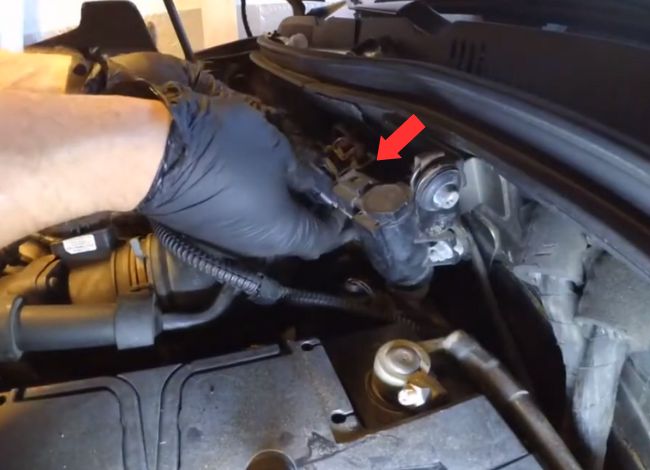Last Updated on April 22, 2025
The P2196 OBD2 code is a diagnostic trouble code (DTC) that stands for: “O2 Sensor Signal Biased/Stuck Rich (Bank 1, Sensor 1).”
In simple terms, this code indicates that the upstream oxygen sensor (sensor 1) on Bank 1 is detecting a constant rich fuel condition—meaning too much fuel and not enough air in the air-fuel mixture. Bank 1 refers to the side of the engine that contains cylinder number 1, while Sensor 1 is located before the catalytic converter, typically in the exhaust manifold.
This issue affects the vehicle’s fuel system performance and emissions, often causing poor fuel economy, engine misfires, rough idling, or black smoke from the exhaust.
Quick Overview of the P2196 Code
Common Causes:
- Faulty or contaminated oxygen sensor (O2 sensor)
- Vacuum leaks or exhaust leaks near the sensor
- Dirty mass airflow sensor (MAF)
- Excess fuel pressure due to a faulty fuel pressure regulator
- Defective engine coolant temperature (ECT) sensor
- Rich running conditions (too much fuel being injected)
Common Symptoms:
- Check Engine Light (CEL) illumination
- Decreased fuel economy
- Black smoke from the exhaust
- Engine hesitation or misfires
- Rough idling or difficulty starting
- Strong smell of gasoline in the exhaust
What Causes the P2196 Code? – Detailed Breakdown
Understanding the root causes of the P2196 OBD2 code is crucial for accurate diagnostics and effective repairs. This code is triggered when the upstream oxygen sensor (Bank 1, Sensor 1) detects a consistently rich air-fuel mixture—meaning there’s too much fuel and not enough oxygen. Below are the most common causes explained in detail:
✅ Faulty Oxygen Sensor (Bank 1 Sensor 1)
The oxygen sensor plays a vital role in maintaining an optimal air-fuel ratio. Over time, this sensor may degrade due to high heat, soot buildup, or age. When the sensor becomes “stuck rich,” it fails to fluctuate between lean and rich readings as it should, sending incorrect data to the engine control module (ECM), thus triggering the code.
✅ Exhaust Leaks Near the Sensor
A leak in the exhaust manifold or pipe near the oxygen sensor can introduce additional oxygen into the exhaust stream. This alters the readings, making the sensor believe the engine is running lean, prompting the ECM to inject more fuel—resulting in a rich condition.
✅ High Fuel Pressure
Excessive fuel pressure caused by a faulty fuel pressure regulator, stuck fuel injector, or blocked return line can flood the engine with more fuel than needed. This makes the combustion mixture richer than intended and sets off the code.
✅ Dirty or Faulty Mass Air Flow (MAF) Sensor
The MAF sensor calculates how much air enters the engine. If it is contaminated or malfunctioning, it may under-report the airflow, causing the ECM to inject too much fuel to compensate, leading to a rich mixture and ultimately triggering P2196.
✅ Leaking or Faulty Fuel Injectors
Injectors that are stuck open or leaking continue to spray fuel into the cylinders, even when not required. This leads to excess fuel entering the combustion chamber, causing rich conditions and activating the trouble code.
✅ Malfunctioning Engine Coolant Temperature (ECT) Sensor
If the ECT sensor sends incorrect data indicating the engine is colder than it really is, the ECM will unnecessarily enrich the fuel mixture to compensate for cold-start conditions, resulting in a rich-running engine.
✅ Air Filter or Intake Blockage
A clogged air filter restricts airflow into the engine, skewing the air-fuel ratio toward richness. This imbalance can lead the oxygen sensor to report a stuck-rich condition.
✅ Electrical Issues or Short Circuits
Wiring problems or short circuits in the O2 sensor circuit can interfere with the voltage signals. If the sensor appears to be reading a consistently rich condition due to electrical faults, the ECM may store the P2196 code even if the mixture is normal.
How to Diagnose the P2196 Code?
Diagnosing the P2196 code requires a methodical, step-by-step approach to identify the exact cause of the rich condition or false sensor reading. Here’s a comprehensive guide:
Step 1: Scan for Codes
Use an OBD2 diagnostic scanner to read and document the trouble codes. In addition to P2196, there may be other related codes like P0172 (System Too Rich) or P2198, which can offer clues about the overall fuel and air balance.
Step 2: Visual Inspection
Carefully inspect the O2 sensor wiring and connectors for signs of damage, corrosion, or loose connections. Also, check for any broken vacuum hoses, cracked intake tubes, or obvious exhaust leaks that could affect sensor readings.
Step 3: Monitor Live Data
Use a scan tool to observe live data from the Bank 1 Sensor 1 O2 sensor. A properly functioning sensor should cycle between 0.1V (lean) and 0.9V (rich). If the voltage is consistently high, it suggests a stuck-rich condition.
Step 4: Test Fuel Pressure
Connect a fuel pressure gauge and compare the reading with the manufacturer’s specifications. If the pressure is too high, the fuel pressure regulator or return line may be faulty or clogged.
Step 5: Check for Exhaust Leaks
Use a smoke machine or listen for hissing sounds around the exhaust manifold and upstream pipe. Even small leaks can throw off oxygen sensor readings.
Step 6: Inspect and Clean MAF Sensor
Remove and inspect the mass airflow sensor. If it appears dirty or oily, clean it using MAF sensor cleaner. A bad MAF reading can throw off fuel calculations, resulting in rich conditions.
Step 7: Inspect Spark Plugs
Remove a few spark plugs and inspect their condition. Black and sooty plugs indicate excess fuel. This also confirms that the rich condition is genuine, not just a false sensor reading.
Step 8: Evaluate ECT Sensor Readings
Check the coolant temperature data from your scan tool. If the temperature seems abnormally low despite the engine being warm, the sensor might be faulty and misleading the ECM into enriching the fuel mix.
Step 9: Test or Replace the O2 Sensor
If all else checks out, the oxygen sensor may be stuck or slow to respond. Replacing it with a high-quality OEM sensor is often the best course of action.
How to Fix the P2196 Code?
Fixing the P2196 code depends on the specific cause determined during the diagnostic process. Here’s a list of proven solutions matched with their respective problems:
✅ Replace Faulty Oxygen Sensor
If the upstream sensor on Bank 1 is confirmed to be faulty or stuck, replacing it usually resolves the issue. Be sure to use a compatible sensor recommended by the vehicle manufacturer.
✅ Repair Exhaust Leaks
If any leak is found upstream of the sensor, it must be repaired. This may involve sealing the exhaust manifold, replacing gaskets, or welding small cracks.
✅ Fix Fuel Pressure Issues
Replace or repair a faulty fuel pressure regulator, damaged return line, or clogged fuel rail to bring fuel pressure back to normal range. Leaky or stuck injectors should also be cleaned or replaced.
✅ Clean or Replace the MAF Sensor
If the mass airflow sensor is found to be dirty or sending incorrect readings, clean it carefully. If it’s damaged or worn out, replace it.
✅ Replace Air Filter
A clean air filter ensures proper airflow into the engine. A clogged filter can create an artificial rich condition, so replace it if it appears dirty.
✅ Address Ignition System Faults
Replace worn spark plugs, coils, or ignition wires to prevent incomplete combustion and reduce excess fuel in the exhaust.
✅ Replace the ECT Sensor
If the coolant temperature sensor is sending inaccurate data, replace it. This ensures the ECM makes accurate fuel delivery decisions based on engine temperature.
✅ Check and Fix Wiring Issues
If there are shorts, broken wires, or poor connections in the O2 sensor circuit, repair or replace the wiring harness. Ensure solid ground and power supply to the sensor.
✅ Reprogram ECM (if applicable)
In rare cases, a software update from the vehicle manufacturer may be needed to correct incorrect sensor interpretation or adaptive fuel strategy.
Let me know if you’d like to add:
- A troubleshooting table
- Internal linking suggestions to related codes (e.g., P0172, P2198)
- Or if you’d like this formatted in HTML for direct WordPress use.
How Serious is the P2196 Code?
The P2196 code is moderately serious. While your vehicle may still run, the long-term consequences can be severe if ignored:
- Poor fuel economy (due to excessive fuel being burned)
- Catalytic converter damage, which is expensive to repair
- Engine misfires and rough running, leading to drivability issues
- Potential for increased emissions, causing failed smog tests
- Risk of fire or overheating, especially if the exhaust gets too hot
If your check engine light is flashing, it’s best to stop driving immediately and address the issue.
Prevention Tips
Here are a few preventive measures to avoid running into the P2196 error:
- Perform regular O2 sensor inspections
- Keep your air filter and MAF sensor clean
- Monitor fuel pressure with scheduled maintenance
- Use only quality fuel and avoid overfilling your tank
- Replace spark plugs and ignition components at regular intervals
Frequently Asked Questions (FAQs)
What does P2196 mean on a Ford or Toyota?
It means the front O2 sensor on Bank 1 is reporting a consistently rich mixture. It’s the same basic issue across brands but may have brand-specific causes.
Can I drive with code P2196?
You can, but it’s not recommended. Extended driving can lead to costly damage, especially to the catalytic converter.
How much does it cost to fix code P2196?
Repairs can cost between $150 to $600, depending on whether you’re replacing just the O2 sensor or dealing with deeper fuel system issues.
Can a bad MAF sensor trigger P2196?
Yes. A faulty MAF sensor can skew air-fuel readings, causing the system to run rich and set this code.
Will cleaning the O2 sensor fix the code?
Sometimes, if the sensor is only slightly contaminated. However, most often it will need to be replaced.
Final Thoughts
The P2196 OBD2 code can be frustrating, especially when accompanied by poor fuel economy, rough idling, or a persistent check engine light. However, with the right diagnosis and a clear repair strategy, the issue can be resolved efficiently. Don’t ignore it—acting quickly can save you from expensive repairs down the line.
If you’re unsure about performing these tasks yourself, consult a professional mechanic to avoid further damage.
Related Trouble Codes
Kevin Nicholas is an automotive technician who is a genius at software and hardware-related issues. He manually tested more than a hundred OBD scanners and gave his honest opinion on whether the device was worth the money or not. His in-depth OBD review articles help people choose the right product, whether it is a European, American, or Asian vehicle. He completed his Automotive Specialized Training Course at Universal Technical Institute and has more than 15 years of experience in the field.
